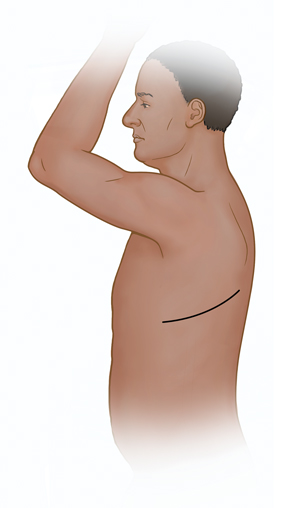Thoracotomy
Thoracotomy is surgery used to diagnose and treat certain lung problems. The surgeon makes a cut (incision) through the skin, usually between the ribs, or may remove a rib. They then cut through the lining around the lungs. They may take a sample of lung tissue (biopsy). Or the surgeon may take out a tumor or mass, or part or all of a lung. Sometimes surgeons use a thoracotomy to operate on the esophagus or for certain heart procedures.
 |
| Possible incision site for thoracotomy. |
Getting ready for your surgery
-
Ask your health care team any questions you have about the procedure.
-
Have blood tests or other tests that your health care provider suggests.
-
Ask your provider about donating your own blood before the procedure.
-
If you smoke, use smokeless tobacco, electronic cigarettes, or vaping devices, stop right away. Let your provider know if you drink large amounts of alcohol or use recreational drugs.
-
Tell your healthcare team about any medicines you're taking, including aspirin. Ask if you should stop taking them. Also mention any vitamins, herbs, or other supplements you take.
-
Also tell your care team about any allergies that you have, including medicines, foods, tape, and latex.
-
Follow any directions you are given for not eating or drinking before surgery.
The surgery
-
The anesthesiologist can discuss the types of medicines you'll be given during the surgery and answer your questions. After you're asleep, you're put in a comfortable position on your side and covered with sterile drapes.
-
The lung to be operated on is deflated. A breathing tube helps your other lung continue working.
-
Your surgeon makes an incision across your side. They separate your rib cage or remove a rib to reach your lungs. The surgeon can look at the deflated lung and do the needed surgery. In some cases, the surgeon may remove part or all of the lung and nearby lymph nodes.
-
When the procedure is finished, the surgeon puts one or more tubes in your chest for a short time. These are to drain fluid and air.
-
The surgeon then repairs the rib cage. They close the muscle and skin with stitches or staples.
-
You will wake up in a recovery area. Or you may be in the ICU (intensive care unit). Your breathing tube is generally taken out before or just after you wake up.
Risks and possible complications
The risks of having a thoracotomy include:
-
The risks of general anesthesia.
-
Infections. This could be in the wound, in the lungs (pneumonia), or in the bloodstream.
-
Too much bleeding. This might require a blood transfusion.
-
An air leak through the lung wall. This requires a longer hospital stay or another operation.
-
A collapsed lung that doesn't get better.
-
Delirium.
-
A blood clot in a blood vessel in the leg (deep vein thrombosis) with potential for blood clots in the lung (pulmonary embolism).
-
Pain. In some cases, pain may continue beyond the normal recovery period.
-
Death.
Online Medical Reviewer:
Mary Mancini MD
Online Medical Reviewer:
Stacey Wojcik MBA BSN RN
Online Medical Reviewer:
Terri Koson DNP RN ACNP
Date Last Reviewed:
2/1/2025
© 2000-2025 The StayWell Company, LLC. All rights reserved. This information is not intended as a substitute for professional medical care. Always follow your healthcare professional's instructions.